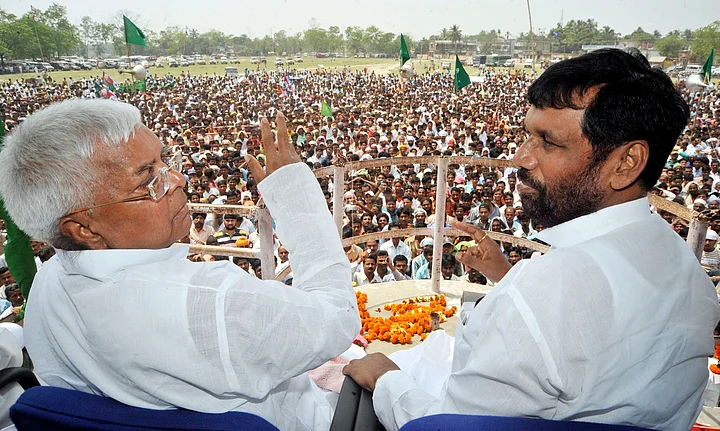Even as Bihar’s Janata Parivar constituents, the RJD and JD(U), struggle to iron out their seemingly interminable differences, capturing the decisive Dalit and Yadav votes have become central to the electoral strategies of all parties, including the BJP.
While the intensity of caste and identity politics has reduced marginally in Bihar since 2005, when the Nitish Kumar-led JD(U), in alliance with the BJP, won that year’s assembly election, it continues to be the main variable that impacts on electoral outcomes in the state. In 2005 as well as 2010, when Nitish’s returned to power, the JD(U)’s social engineering involving the other backward castes had stirred the caste cauldron.
The Yadavs, the dominant caste group constituting between 12% and 15% of the population, is now up for grabs, especially with reports suggesting that the BJP will no stone unturned to woo them in the face of the Lalu Prasad-led RJD’s resurgence. With the JD(U) in power for two consecutive terms, the Yadavs now lack the clout they enjoyed during the heyday of Lalu and his wife Rabri Devi’s chief ministership when they held key positions in the civil service and the petty bureaucracy.
BJP Courting Yadavs
The community backed Ram Kripal Yadav against Misa, Lalu’s daughter, in the 2014 Lok Sabha election. While Lalu continues to have an emotional connect with a section of the Yadavs, the BJP’s aggressive courting of the community and RJD MP from Madhepura Pappu Yadav’s rebellion barely three months before the assembly elections may hurt the RJD supremo’s prospects.
Pappu Yadav defeated the JD(U)’s Sharad Yadav in Madhepura last year, thereby laying claim to being the new favourite of the Yadavs. If he manages to continue his domination in eastern Bihar he will be a much sought after ally for Jitanram Manjhi as well as the BJP.
Loss of Pre-eminence
The Yadavs witnessed an unprecedented brightening of fortunes in the wake of the Mandal wave in the late Eighties. But they saw a steady decline in their clout over the past quarter century. In the 1990 assembly elections, 63 Yadavs were elected as MLAs. Their social and political power reached its apogee in 1995 when 86 Yadavs made it to the assembly. But Lalu’s fall from grace because of the stigma of the fodder scam, hastened the process of the Yadavs’ loss of preeminence. Beginning 2000, they gradually began losing numbers in the assembly and in the 2010 polls ended up with just 39 legislators.
Should the BJP field Nand Kishore Yadav, the leader of the opposition in the Bihar assembly, as the chief ministerial candidate, he may pull in a large section of the Yadavs. Along with Nand Kishore, the BJP is banking on Ram Kripal Yadav to garner the Yadav votes.
Yadavs vs Yadavs
BJP president Amit Shah made Bhupendra Yadav a Rajya Sabha member from Rajasthan in-charge of party affairs in Bihar just before last year’s Jharkhand assembly polls. Bhupendra Yadav gambled by fielding some strong Yadav leaders from urban seats in the 2014 Lok Sabha election. This move paid dividends when all the four Yadav candidates fielded by the BJP — Ram Kripal Yadav (Patliputra), Om Prakash Yadav (Siwan), Nityanand Rai (Ujiarpur) and Hukum Deo Narayan Yadav (Madhubani) — defeated their RJD rivals.
A section of the state BJP feels that in the event of the ‘Modi magic’ not working to the extent it did in the parliamentary elections — the party won 31 of 43 seats in alliance with two partners — it might have to take recourse to a social engineering involving the Yadavs. According to party sources, this strategy would be help drive a wedge in the secular votes that includes Muslims.
